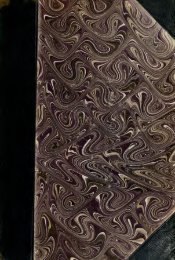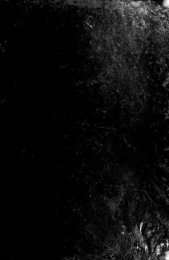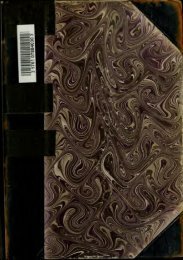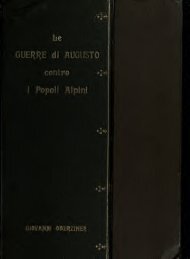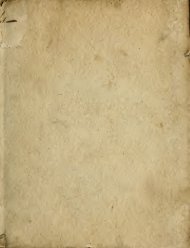Figurative uses of animal names in Latin and their ... - mura di tutti
Figurative uses of animal names in Latin and their ... - mura di tutti
Figurative uses of animal names in Latin and their ... - mura di tutti
Create successful ePaper yourself
Turn your PDF publications into a flip-book with our unique Google optimized e-Paper software.
Infra<br />
:<br />
24<br />
Fuit Cancer <strong>in</strong>strumentum magnum forte, pariter et ponderosum.<br />
In eo erat trabs magna, pariter longa, <strong>in</strong> una<br />
parte grossa, <strong>in</strong> altera parva. In grossiori parte, sive <strong>in</strong><br />
capite, fuit ferro forti circumdata, et <strong>in</strong> fronte ipsius Can-<br />
cri fortissime colligata. Trabs haec super quaedam <strong>in</strong>strumenta<br />
jacuit, quod faciliter moveretur. Hie Cancer cum<br />
ad murum pervenisset, et octo <strong>in</strong> circulos, qui <strong>in</strong> trabe erant,<br />
funes immisissent, ex paucis ictibus pro magna parte cadere<br />
coegerunt.<br />
Mox:<br />
Ex parte terrae fuerunt obsessi per Cattum atque Cancrum;<br />
quia solus Cancer, qu<strong>in</strong>gentos hom<strong>in</strong>es occupabat.-'^^<br />
Another <strong>in</strong>stance <strong>of</strong> the testudo type <strong>of</strong> mach<strong>in</strong>e is found<br />
: Unum fuit mach<strong>in</strong>amentum, quod nostri<br />
<strong>in</strong> sus, ' the sow '<br />
Suem, veteres V<strong>in</strong>eam vocant, quod . . . protegit <strong>in</strong> se sub-<br />
sidentes, qui quasi more suis, ad murorum suffo<strong>di</strong>enda pene-<br />
trant fundamenta.<br />
The locusta was a somewhat similar device :<br />
Locusta ambulatoria:<br />
<strong>in</strong>tus hom<strong>in</strong>es ducentes eam, possunt se haerere<br />
muro aut prope murum castelli et defendere se a saxis<br />
hostium ac missilibus.-'^-'*<br />
The English has a rather strik<strong>in</strong>g figure prompted by<br />
the shape <strong>of</strong> the tortoise. To turn turtle, is common <strong>in</strong> nau-<br />
tical slang <strong>and</strong> its application has been extended to other<br />
fields. The figure is due, <strong>of</strong> course, to the shape <strong>of</strong> the<br />
hull <strong>of</strong> the capsized vessel.<br />
Turtle is also used <strong>of</strong> the detachable segment <strong>of</strong> a rotary<br />
pr<strong>in</strong>t<strong>in</strong>g-mach<strong>in</strong>e.<br />
TESTUDO ARIETARIA.<br />
Vitruvius, after describ<strong>in</strong>g the <strong>in</strong>vention <strong>of</strong> the simple<br />
aries whose weight was supported by men, tells <strong>in</strong> detail<br />
how it was made more efficient. It was supported on a<br />
cross-beam; then it was rendered movable by a platform<br />
"' Quoted by Du Cange, s. v. Cancer.<br />
"^ Quoted by Du Cange, s. v. Sus.<br />
Quoted by Du Cange, s. v. Locusta.


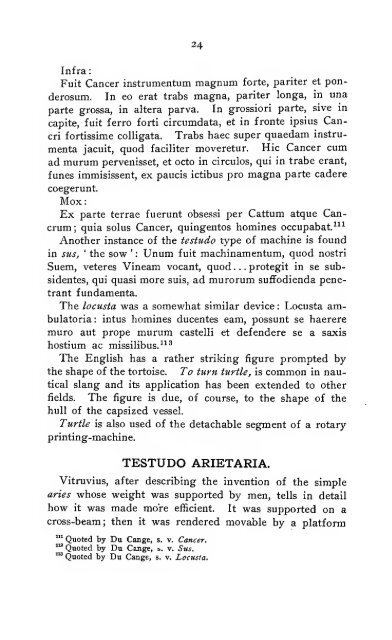
![Das Kriegswesen der Alten [microform] - mura di tutti](https://img.yumpu.com/21606999/1/167x260/das-kriegswesen-der-alten-microform-mura-di-tutti.jpg?quality=85)


